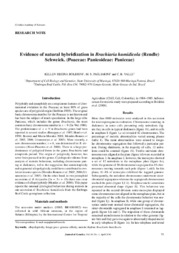Evidence of natural hybridization in Brachiaria humidicola (Rendle) Schweick. (Poaceae: Panicoideae: Paniceae).
Evidence of natural hybridization in Brachiaria humidicola (Rendle) Schweick. (Poaceae: Panicoideae: Paniceae).
Author(s): BOLDRINI, K. R.; PAGLIARINI, M. S.; VALLE, C. B. do
Summary: Polyploidy and aneuploidy are conspicuous features of chromosomal evolution in the Poaceae; at least 80% of grass species are of polyploid origin (Stebbins 1985). The original basic chromosome number for the Poaceae is not known and has been the subject of much speculation. In the large tribe Paniceae, which includes the genus Brachiaria, the most common basic chromosome number is x = 9 (DeWet 1986). The predominance of x = 9 in Brachiaria genus had been reported in several studies (Basappa et al. 1987; Honfi et al. 1990; Bernini and Marin-Morales 2001; Mendes-Bonato et al. 2002, 2006; Utsunomiya et al. 2005). More recently, a new chromosome number, x = 6, was determined for B. dictyoneura (Risso-Pascotto et al. 2006). There is a large predominance of polyploid forms in the genus Brachiaria and tetraploids prevail. The origin of polyploidy, however, has never been pursued in this genus. Cytological evidence from analysis of meiotic behaviour, including chromosome pairing at diakinesis, led to the suggestion that autotetraploidy and segmental allopolyploidy could have contributed to evolution in some species (Mendes-Bonato et al. 2002, 2006;Utsunomiya et al. 2005). On the other hand, in two pentaploid accessions of B. brizantha (2n = 5x = 45) there was clear evidence of allopolyploidy (Mendes et al. 2006). This paper reports the unusual cytological behaviour during meiosis in one accession of Brachiaria humidicola from the Embrapa Beef Cattle germplasm collection.
Publication year: 2010
Types of publication: Journal article
Unit: Embrapa Beef Cattle
Observation
Some of Embrapa's publications are published as ePub files. To read them, use or download one of the following free software options to your computer or mobile device. Android: Google Play Books; IOS: iBooks; Windows and Linux: Calibre.
Access other publications
Access the Agricultural Research Database (BDPA) to consult Embrapa's full library collection and records.
Visit Embrapa Bookstore to purchase books and other publications sold by Embrapa.

